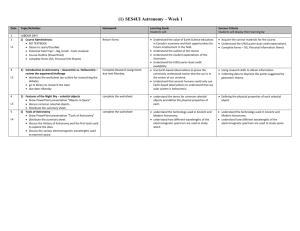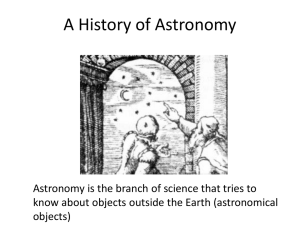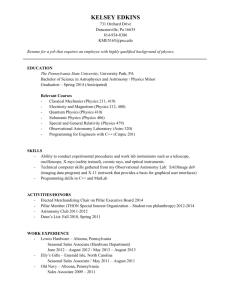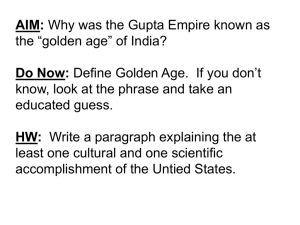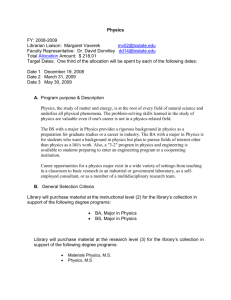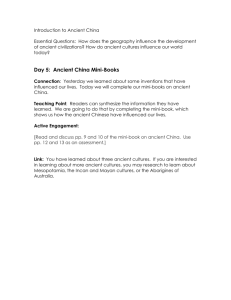Astronomy in Ancient Cultures Project Fall 2013
advertisement
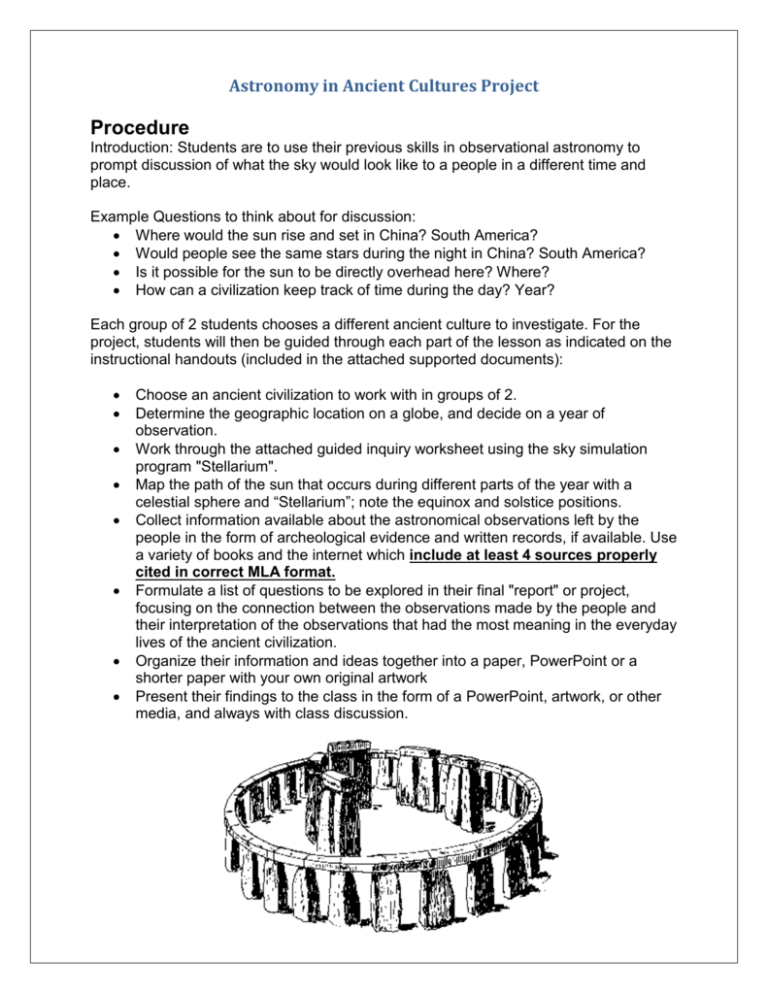
Astronomy in Ancient Cultures Project Procedure Introduction: Students are to use their previous skills in observational astronomy to prompt discussion of what the sky would look like to a people in a different time and place. Example Questions to think about for discussion: Where would the sun rise and set in China? South America? Would people see the same stars during the night in China? South America? Is it possible for the sun to be directly overhead here? Where? How can a civilization keep track of time during the day? Year? Each group of 2 students chooses a different ancient culture to investigate. For the project, students will then be guided through each part of the lesson as indicated on the instructional handouts (included in the attached supported documents): Choose an ancient civilization to work with in groups of 2. Determine the geographic location on a globe, and decide on a year of observation. Work through the attached guided inquiry worksheet using the sky simulation program "Stellarium". Map the path of the sun that occurs during different parts of the year with a celestial sphere and “Stellarium”; note the equinox and solstice positions. Collect information available about the astronomical observations left by the people in the form of archeological evidence and written records, if available. Use a variety of books and the internet which include at least 4 sources properly cited in correct MLA format. Formulate a list of questions to be explored in their final "report" or project, focusing on the connection between the observations made by the people and their interpretation of the observations that had the most meaning in the everyday lives of the ancient civilization. Organize their information and ideas together into a paper, PowerPoint or a shorter paper with your own original artwork Present their findings to the class in the form of a PowerPoint, artwork, or other media, and always with class discussion. NAME: Group Members: Astronomy in Ancient Cultures Project Objectives: 1. Choose an ancient culture and find out what the sky looked like to these people throughout the year. Map sunrise and sunset positions in the sky, position of a pole star and the path of the sun during the day and the stars at night. Are there other significant observations? 2. Determine what evidence is available about this culture: ancient monuments, archeology, and written records or myths and legends that record astronomical observations and/or interpretations of astronomical observations made by the people. 3. Develop questions and investigate answers about the significance of astronomy to this culture. “Archeoastronomy” is the study of the practice of astronomy by ancient cultures of the world. Our project for the sky observation part of the Astronomy Course is to view the sky from the perspective of a culture that existed before recorded history. We are looking for a time when a people determined the time of day, day of the year, and seasons in a yearly cycle from the motions of the sky rather than a calendar or clock. Your project will be to examine the sky as one ancient people would have observed it. You will have use of the “Stellarium” sky simulation program to help you. Then, you will research the evidence available about the astronomical observations they recorded. Explore the relationship the people had to the sky through their values and stories using the internet and books that have been collected for your use. The project will consist of the following parts: A. 5 points Choose a pre-historic peoples from the following list B. Complete Worksheet #1 & 2 on the view of the sky for these people using 10 points the sky simulation program “Stellarium”. C. 30 points Collect information about the archeology and legends that have survived from the people you have chosen. Use Worksheets #3-6 as a guide to find out everything available about this culture. Be sure to write down the references you have used. D. 10 points Formulate a list of questions to be explored in the final “report” of your project. You may use the list from Worksheet #3 and also ask questions of your own. Focus on the connection between the observations made by the people and their interpretation of the observations that had the most meaning in their everyday lives. E. 40 points Organize your information and ideas together into a paper, PowerPoint, or a shorter paper with your own original artwork. Be sure to include diagrams and illustrations of archeology and the patterns in the sky that are needed to tell the stories of the people. F. 10 points Present your findings to the class. Use the document camera to display diagrams and patterns of stars in the sky. Discuss the contents of the worksheets you have completed about the people’s view of the sky and the relevance to their culture. The presentation will be waived if you complete this project alone. 105 TOTAL POINTS POSSIBLE What should your project include? Title: (and subtitle which reflects the nature of your investigation) Introduction: Paragraph of 5–6 sentences which include the name, approximate time, location of the people you are studying. Include the most significant aspect of the sky as they would have seen it and the major relevance to their lives and culture. Observations: Diagrams and word descriptions of the observations of the sun, planets, stars, pole star and other noteworthy events (such as aurora) that would have been observed by these people. Include the sunrise and sunset positions, positions of the solstices and equinoxes, length of day at different times of the year. Archeological and/or Written evidence of astronomy as used by this group of people. Correlate the observations you did with the sky simulation and sun hemisphere with these records. Detail all astronomical observations that were recorded by this culture. Detail the calendar or other device used to keep track of time. Conclusions: Choose 2 questions you have asked, discussed with your group and formed a hypothesis about pertaining to this culture’s observations and the connection to their belief system or “world view”. This should bring all the evidence in your paper together. Length varies depending on the format. Research papers can be expected to be about 3-5 double spaced pages plus about 3-5 more pages of diagrams and pictures with at least 4 references listed in a Works Cited. A power-point presentation should have a comparable amount of information with 15–25 slides (depending on how much is on each slide). Creativity is encouraged, with ongoing discussions with the teacher about what and how much is included. Peoples you can choose from (remember, these are from ancient pre-historic times). The underlined locations/peoples have more available information than others: Location Peoples and Places Southwest U.S. Anasazi, currently Navajo (Hovenweep, Chaco Canyon, Mesa Verdi), Hopi, Zuni – also Petroglyph Calenders. Shaw Butte Prehistoric Observatory (Phoenix, AZ) Cherokee, Pawnee and Sioux (plains, including Big Horn Medicine Wheel, Wyoming), Chumash (California, Viejas Mountain), Inuit (Alaska), and others Stonehenge builders – Neolithic age, Celtics – many stone circles Mayans – Chichen Itza and Caracol tower, Aztecs (Quetzacoatl, Templo Mayor) Incas (including Cuzco), sun towers, Intihuatana Mesopotamia, Babylonia and Arabia (built Astrolabes) Aborigines (also Maori in New Zealand) Norse Egyptians and the pyramids of Giza Polynesia, India (Jantar-Mantars), Central or Eastern Europe, China, Africa (myths, less monuments), Greece. North American Indian England Mexico South America Middle East Australian Iceland Egypt Other cultures Internet Resources to Get You Started 1. Multicultural Astronomy: The Astronomy of Non-western Cultures: A Resource Guide: http://www.astrosociety.org/education/resources/multi.html 2. Windows to the Universe: http://www.windows.ucar.edu/ 3. Archaeoastronomy: http://www.archaeolink.com/archaeoastronomy.htm 4. Thinkquest Archaeoastronomy: http://library.thinkquest.org/C0118421/largemain.html 5. Ancient Astronomy: http://www.astronomy.pomona.edu/archeo/ 6. Wikipedia: http://en.wikipedia.org/wiki/Category:Ancient_astronomy - Be sure to confirm your findings from this site with other sources! 7. Ancient Observatories: http://facstaff.gpc.edu/~pgore/astronomy/astr101/ancient.htm 8. Starry Messenger: http://www.hps.cam.ac.uk/starry/ 9. History of Astronomy Links: http://outreach.as.utexas.edu/marykay/history.html 10. History of Astronomy Resources: http://www.ccsd.edu/south/science/esci/akarsten/Astronomy/historywebquest/resourceshisto ry.htm 11. More History of Astronomy Resources: http://woub.org/etseo/spacedout/video7/print.php 12. Star Teach Astronomy Education: http://starteachastronomy.com/archaeoastronomy.html NAME: Group Members: Astronomy in Ancient Cultures Project Worksheet #1 Directions: Use Stellarium to complete the following information Ancient Culture: Modern day location (nearest city): The Sun: 1. December 21 Solstice March 21 Equinox June 21 Solstice September 21 Equinox Azimuth of Sunrise Azimuth of Sunset Highest altitude of the Sun Is there a “zenith” passage Is the sun ever circumpolar? If so, when? If so, when? 2. Draw the path of the Sun during the two solstices and the equinox on the dome below: (4 points) NAME: Group Members: Astronomy in Ancient Cultures Project Worksheet #2 Directions: Use Stellarium to complete the following information Ancient Culture: Modern day location (nearest city): The Stars: 3. Where is the position of the North (or South) Celestial Pole among the stars? Note the distance (in degrees) to the nearest naked eye star. ______________________ 4. Let the time advance through a night time and trace the “Star Trails” (how do the stars appear to move over time) looking in each direction: 5. What times of the year is the Milky Way visible? Note if the Milky Way goes across the horizon or a path directly overhead. 6. The Ecliptic is roughly the path of the Sun, Moon and Planets which orbit in the plane of our solar system. The moon and planets go across the sky in a motion like that which you drew for the Sun on the dome above. Are the moon and planets easily visible in the sky? NAME: Group Members: Astronomy in Ancient Cultures Project Worksheet #3 QUESTIONS TO BE ANSWERED ABOUT THE PEOPLE YOU HAVE CHOSEN: Answer as many of these as possible. Much information has survived through legends or monuments, though much may not be attainable. Occasionally, it may be appropriate to make good guesses (theories). Write out answers to each of these to prepare for the paper and presentation. Be sure to write down references to use in your works cited!! 1. What is the astronomical system: who observes (or what is observed) what, when, where, how and why? 2. What records for astronomical observations were kept? Explain in detail the records or monuments that have survived to this day, and how they recorded the different astronomical observations. 3. Explain the observations used to keep a type of calendar. How do these people keep track of the specific dates of the year? Do they keep a solar calendar (based on the position of the sun) or a lunar calendar (based on appearances and phases of the moon)? 4. How do astronomical observations relate to other components of culture? This is where you discuss the myths and legends resulting from observations of the stars, the sky and the motion. What constellations were named? What was the significance to the culture, did astronomical sightings mean different activities were done, for instance? NAME: Group Members: Astronomy in Ancient Cultures Project Worksheet #4 QUESTIONS TO BE ANSWERED ABOUT THE PEOPLE YOU HAVE CHOSEN (CONT.): The Sun: 1. Is solar position used to tell time on a daily basis? (If so, note method) 2. Is movement of the sun marked for seasonal activities? What are the seasons, and what activities are associated with each? 3. Are solstices observed and recorded? 4. Are equinoxes observed and recorded? 5. In the Tropics: Did the people note the zenith passages? 6. In the Arctic, how are the summer period of light and the winter’s great darkness perceived and understood? How do people relate to the circumpolar sun (when 24 hour sunlight)? 7. Is a solar eclipse known, and how is it explained? The Moon: 1. What positions of the moon are noted? Especially regarding the reappearing new moon, is it’s angle, size or brightness significant? 2. Is there a system of moon-related months? 3. Are lunar conjunctions with stars/planets noted, and if so, with what significance? 4. Is a lunar eclipse known, and if so, how is it explained? 5. If time is determined by lunar observations (lunar calendar), how do people adjust for the few days difference to coincide with the seasons? NAME: Group Members: Astronomy in Ancient Cultures Project Worksheet #5 QUESTIONS TO BE ANSWERED ABOUT THE PEOPLE YOU HAVE CHOSEN (CONT.): The Stars: 1. What stars/constellations seem to have the greatest cultural significance? 2. Is the celestial pole noted? 3. Are heliacal risings and settings important? (These are objects that rise just before the sun, or set just after the sun, as observed for the first or last time) 4. What stars are used to tell time during the night? 5. What seasonal associations are made with the stars/constellations? 6. Is there an ecliptic-like path noted among the stars? Do they use stars along the celestial equator as significant instead? 7. What is the Milky Way? Are its dark areas observed as “constellations”? 8. Is there significance to the position of the Celestial Pole? For example, some cultures where the stars move overhead they feel they are in the center of the “universe”. Likewise, if a culture sees stars moving around a distant point, they often feel that a “higher power” is a distance away. NAME: Group Members: Astronomy in Ancient Cultures Project Worksheet #6 QUESTIONS TO BE ANSWERED ABOUT THE PEOPLE YOU HAVE CHOSEN (CONT.): The Planets: 1. What planets are observed and why? What planet has the most significance? 2. If Venus and/or Mercury are identifiable, are they recognized as the same planet whether it is in the evening or the morning sky? 3. Are the planets as a group distinguished from the stars? 4. If there is a “morning star” or “evening star” observation, is it considered a planet? 5. Is there a classification for inner/inferior and outer/superior planets? 6. Is there awareness of retrograde motion of the planets? Does this have special significance? Other Celestial Phenomenon: 1. What is the sky? How is movement across it by astronomical objects explained? 2. What is a shooting star/meteor, and what is the reaction to one when directly observed? 3. Are comets known? What are they? What do they mean? 4. What is the aurora borealis (or australis) and its meaning? NAME: Group Members: Astronomy in Ancient Cultures Project Conclusion Worksheet Choose 2 questions you have asked, discussed with your group and formed an hypothesis about pertaining to this culture’s observations and the connection to their belief system or “world view”. This should bring all the evidence in your paper together. Big Questions #1: Big Question #2: Big Question #3 (Optional)

